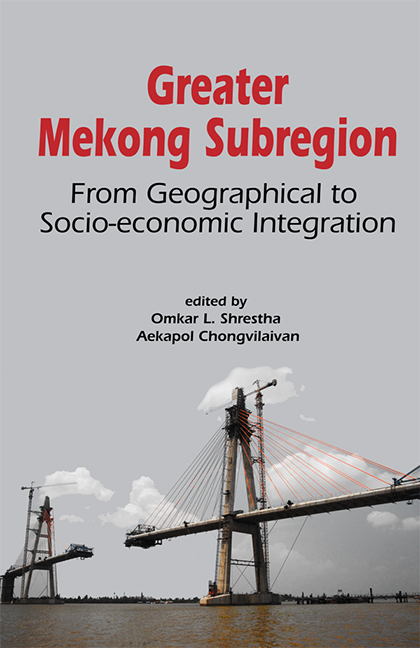Book contents
- Frontmatter
- Contents
- Preface
- List of Abbreviations
- Contributors
- 1 Greater Mekong Subregion: From Geographical Corridors to Socio-economic Corridors
- 2 Cambodia, Its Development, and Integration into the GMS: A Work in Progress
- 3 Subregional Connectivity in the Lao PDR: From Land-locked Disadvantage to Land-linked Advantage
- 4 The Economic Development of Myanmar and the Relevance of the Greater Mekong Subregion
- 5 GMS Challenges for Thailand
- 6 Deepening GMS Cooperation in a More Integrated ASEAN and East Asia
- 7 China (Yunnan)–GMS Economic Cooperation: New Development and New Problems
- 8 Trade and Investment in the Greater Mekong Subregion: Remaining Challenges and the Unfinished Policy Agenda
- 9 Enhancing Financial Cooperation among the GMS Countries
- 10 The Challenges of GMS Regional Integration: Case Study of Governance of the Logistics Industry in Thailand
- 11 Energy Sector Integration for Low-carbon Development in the GMS: Towards a Model of South-South Cooperation
- 12 Linking the Social to the Economic: Broadened Ambitions and Multiple Mitigations in New Mekong Corridors
- Index
3 - Subregional Connectivity in the Lao PDR: From Land-locked Disadvantage to Land-linked Advantage
Published online by Cambridge University Press: 21 October 2015
- Frontmatter
- Contents
- Preface
- List of Abbreviations
- Contributors
- 1 Greater Mekong Subregion: From Geographical Corridors to Socio-economic Corridors
- 2 Cambodia, Its Development, and Integration into the GMS: A Work in Progress
- 3 Subregional Connectivity in the Lao PDR: From Land-locked Disadvantage to Land-linked Advantage
- 4 The Economic Development of Myanmar and the Relevance of the Greater Mekong Subregion
- 5 GMS Challenges for Thailand
- 6 Deepening GMS Cooperation in a More Integrated ASEAN and East Asia
- 7 China (Yunnan)–GMS Economic Cooperation: New Development and New Problems
- 8 Trade and Investment in the Greater Mekong Subregion: Remaining Challenges and the Unfinished Policy Agenda
- 9 Enhancing Financial Cooperation among the GMS Countries
- 10 The Challenges of GMS Regional Integration: Case Study of Governance of the Logistics Industry in Thailand
- 11 Energy Sector Integration for Low-carbon Development in the GMS: Towards a Model of South-South Cooperation
- 12 Linking the Social to the Economic: Broadened Ambitions and Multiple Mitigations in New Mekong Corridors
- Index
Summary
The Lao People's Democratic Republic (Lao PDR) is a landlocked country in Southeast Asia surrounded by the People's Republic of China and Myanmar to the north, Thailand to the west, Vietnam to the east, and Cambodia to the south. The country has a large area of 236,800 square kilometres, a population of 6.6 million inhabitants, and a very low population density of twenty-five persons per square kilometre.
The country is mountainous in the north and the east, and has in the west a number of plains along the Mekong River. The Mekong River and its tributaries are the main water sources that provide abundant natural resources with high socio-economic development potential for agriculture, forestry, fisheries, hydropower, and mining. In addition to those resources, the country has large ethnic diversity and an ancient Lao cultural heritage.
Despite its natural and cultural resources, the Lao PDR has a number of constraints that hamper economic development, such as large mountainous terrain, remote settlements, low population density, and widespread poverty. The country is one of the least-developed countries (LDC) because of its underdeveloped physical infrastructure and human resources, its largely non-monetized economy, and undeveloped public administration and governance frameworks, which have resulted in institutional and regulatory deficiencies that are posing problems and challenges to development.
In the late 1980s the Government of the Lao PDR (GoL) introduced New Economic Mechanisms that aim at reforming public governance from a centrally planned economy to a market oriented economy. Trade liberalization is one pillar of economic reform and this has been accelerated when the Lao PDR joined the Association of South East Asian Nations (ASEAN) in 1987 and agreed to the ASEAN Free Trade Area (AFTA) in 1997. The desire of the government is to develop the country's unfavourable landlocked situation into an effective land-linked position by leveraging the growing market of the neighbouring countries forming the Mekong River subregion of ASEAN and East Asia.
In 1992 the Lao PDR joined a programme of economic cooperation that aims to promote development through closer economic linkages in the Greater Mekong Subregion (the GMS Programme). The GMS Programme, with support from the Asian Development Bank (ADB) and other donors, supported the implementation of high-priority subregional projects in transport, energy, telecommunications, the environment, human resource development, tourism, trade, private sector investment, and agriculture.
- Type
- Chapter
- Information
- Greater Mekong SubregionFrom Geographical to Socio-economic Integration, pp. 31 - 46Publisher: ISEAS–Yusof Ishak InstitutePrint publication year: 2013



